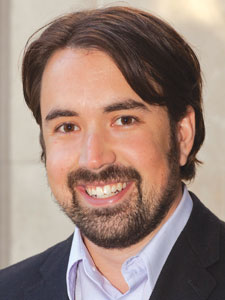Nicholas Turk-Browne
 Princeton University
Princeton University
www.princeton.edu/ntblab
What does your research focus on?
The research in my lab seeks to understand key components of cognition, such as perception and memory. These components are often studied in isolation, with a risk of missing the forest for the trees. The overarching theme of our work is that cognitive processes are inherently interactive — and that studying their behavioral and neural interactions can be especially informative. We investigate learning mechanisms such as “statistical learning” that transform perceptual experience into memory, and attentional mechanisms such as “background connectivity” that regulate this transformation.
What drew you to this line of research and why is it exciting to you?
Perception feels effortless but is actually the product of sophisticated processes operating under the surface. Indeed, accurately perceiving the world requires coping with: jarring input across eye movements, sensory information that is ambiguous, and woeful capacity limitations in attention. Although memory can feel effortful — such as when studying for a test or recalling a name — I am inspired by the idea that complex processes similarly shape memory under the surface. I suspect that such automatic and implicit processes influence memory much more than we yet realize.
Who were/are your mentors or scientific influences?
I am grateful to have had several amazing mentors. As an undergraduate at the University of Toronto, Jay Pratt and later Gus Craik awakened my interests and gave me a taste for research. In graduate school at Yale University, my co-advisors — and enduring intellectual heroes — Marvin Chun and Brian Scholl were incredibly generous, encouraging, and wise; I was also very fortunate to have the opportunity to learn from Marcia Johnson and Greg McCarthy. Finally, as an assistant professor at Princeton University, I am surrounded by many nurturing and inspiring colleagues.
What’s your future research agenda?
My students and postdocs are pursuing a range of exciting questions — here are a few examples: How do different memory systems guide attention? What are the consequences of implicit prediction for perception and memory? What is the role of the hippocampus, and medial temporal lobe more broadly, in the visual processing hierarchy? How does attention restructure functional brain networks to prioritize goal-relevant information? How can real-time fMRI be used to train attention-related behavior?
What publication are you most proud of?
A major focus of the lab has been to characterize the nature of statistical learning — the extraction of regularities in how objects co-occur over space and time, in the service of building representations of words, events, and scenes. We recently discovered that such learning has surprising consequences for other cognitive processes. Namely, an upcoming paper reports that statistical learning automatically controls attention, prioritizing locations and features containing regularities:
Zhao, J., Al-Aidroos, N., & Turk-Browne, N. B. (in press). Attention is spontaneously biased toward regularities. Psychological Science.





APS regularly opens certain online articles for discussion on our website. Effective February 2021, you must be a logged-in APS member to post comments. By posting a comment, you agree to our Community Guidelines and the display of your profile information, including your name and affiliation. Any opinions, findings, conclusions, or recommendations present in article comments are those of the writers and do not necessarily reflect the views of APS or the article’s author. For more information, please see our Community Guidelines.
Please login with your APS account to comment.